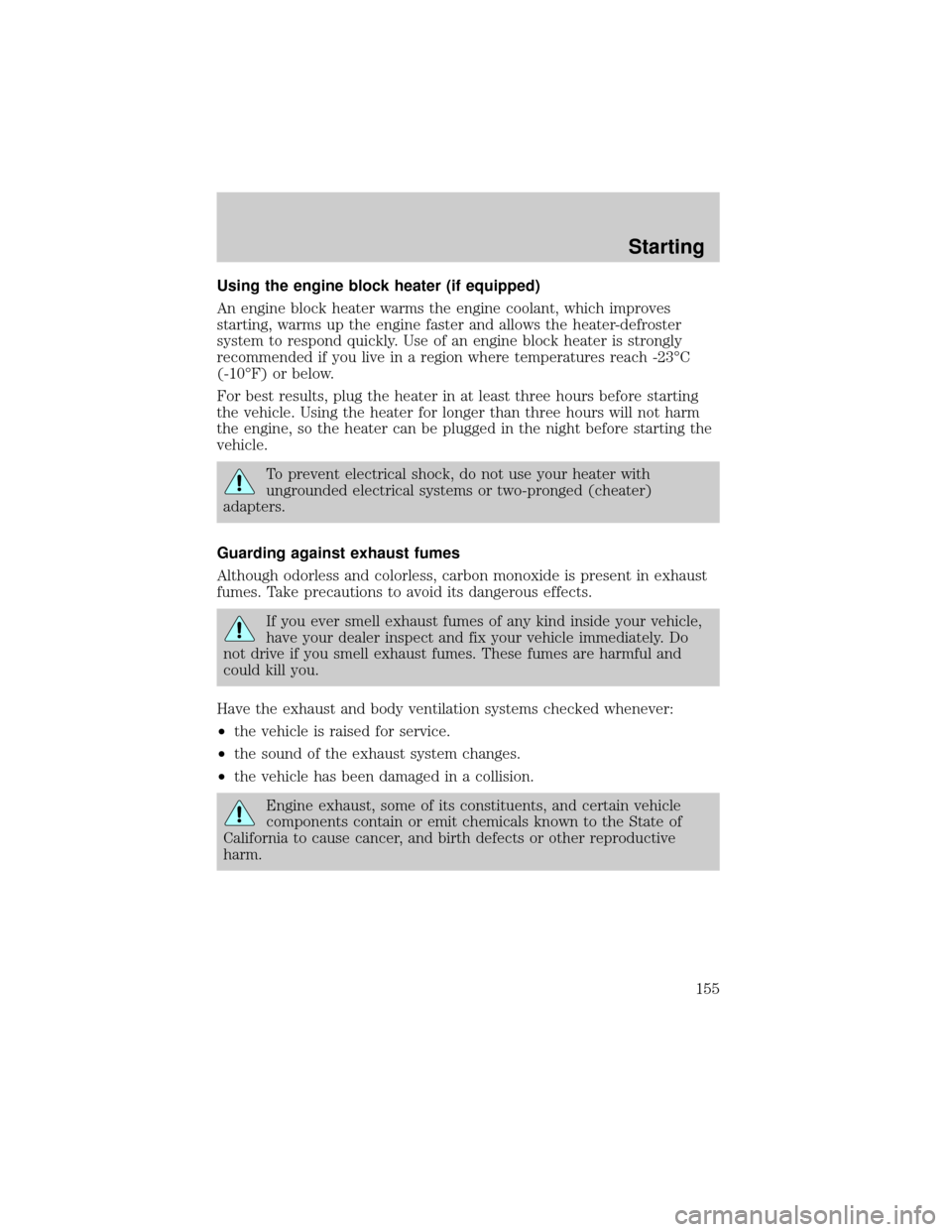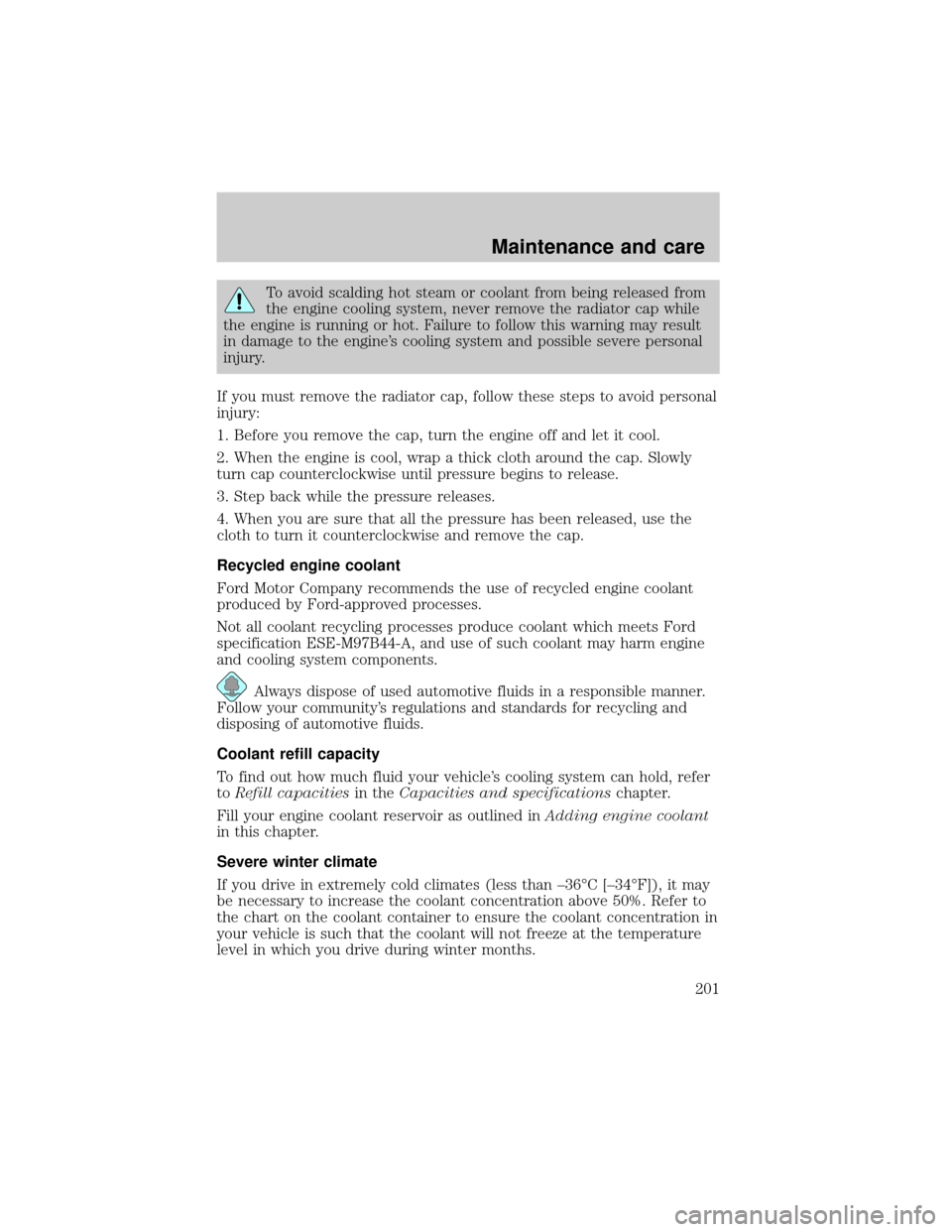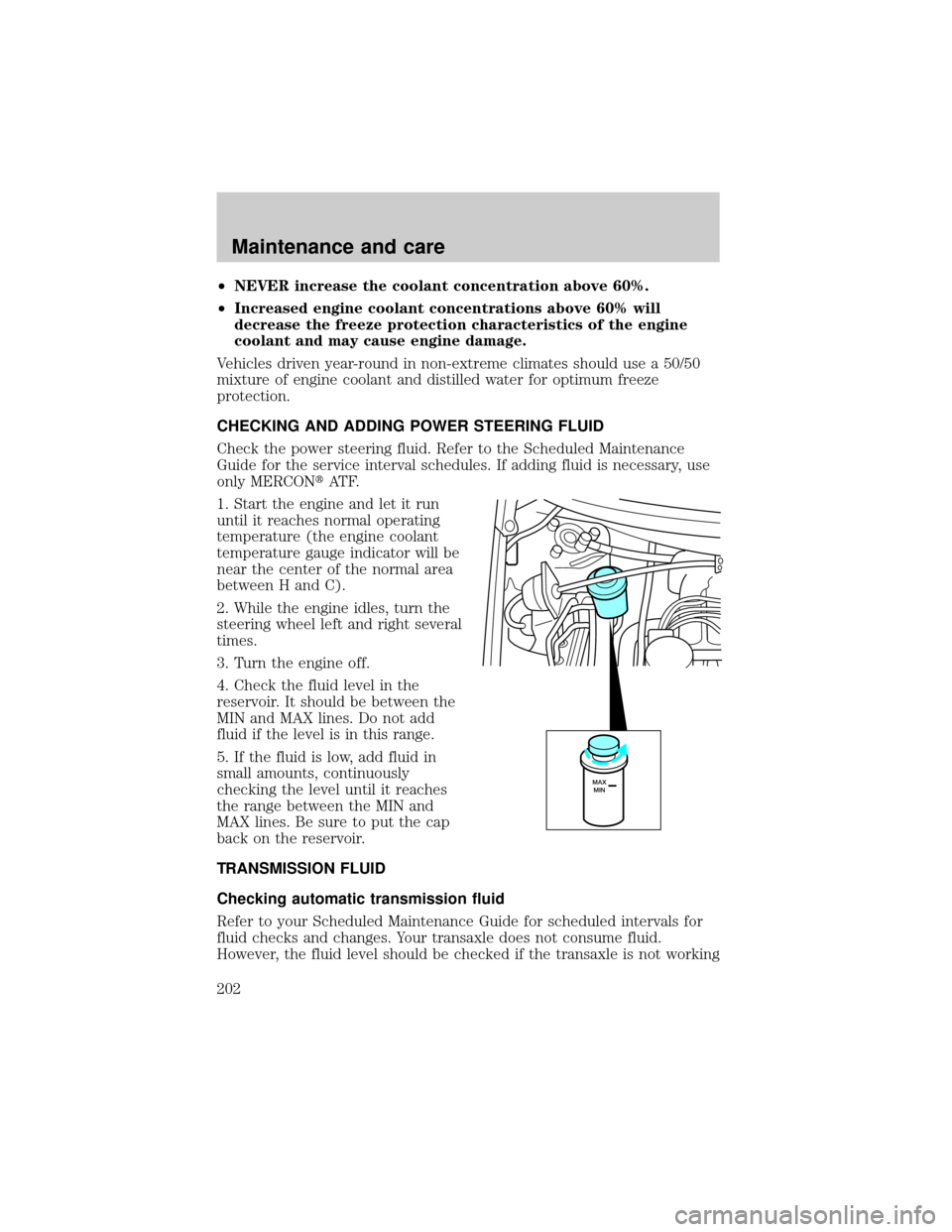coolant temperature Mercury Villager 1999 Owner's Manuals
[x] Cancel search | Manufacturer: MERCURY, Model Year: 1999, Model line: Villager, Model: Mercury Villager 1999Pages: 264, PDF Size: 2.19 MB
Page 14 of 264

empty indication, the amount of fuel that can be added will be less than
the advertised capacity due to the reserve fuel.
┬▓Standard analog instrument
cluster
┬▓Optional electronic instrument
cluster
Engine coolant temperature gauge
Indicates the temperature of the engine coolant. At normal operating
temperature, the needle remains within the normal area (the area
between the ªHº and ªCº). If it enters the red section, the engine is
overheating. Stop the vehicle as soon as safely possible, switch off the
ignition and let it cool. Refer toEngine coolantin theMaintenance
and carechapter.
This gauge indicates the temperature of the engine coolant, not the
coolant level. If the coolant is not at its proper level or mixture, the
gauge indication will not be accurate.
Never remove the radiator cap while the engine is running or
hot.
┬▓Standard analog instrument
cluster
E
F
FUEL
F
E
1/2
C
H
TEMPNORMAL
Instrumentation
14
Page 155 of 264

Using the engine block heater (if equipped)
An engine block heater warms the engine coolant, which improves
starting, warms up the engine faster and allows the heater-defroster
system to respond quickly. Use of an engine block heater is strongly
recommended if you live in a region where temperatures reach -23ÉC
(-10ÉF) or below.
For best results, plug the heater in at least three hours before starting
the vehicle. Using the heater for longer than three hours will not harm
the engine, so the heater can be plugged in the night before starting the
vehicle.
To prevent electrical shock, do not use your heater with
ungrounded electrical systems or two-pronged (cheater)
adapters.
Guarding against exhaust fumes
Although odorless and colorless, carbon monoxide is present in exhaust
fumes. Take precautions to avoid its dangerous effects.
If you ever smell exhaust fumes of any kind inside your vehicle,
have your dealer inspect and fix your vehicle immediately. Do
not drive if you smell exhaust fumes. These fumes are harmful and
could kill you.
Have the exhaust and body ventilation systems checked whenever:
┬▓the vehicle is raised for service.
┬▓the sound of the exhaust system changes.
┬▓the vehicle has been damaged in a collision.
Engine exhaust, some of its constituents, and certain vehicle
components contain or emit chemicals known to the State of
California to cause cancer, and birth defects or other reproductive
harm.
Starting
155
Page 201 of 264

To avoid scalding hot steam or coolant from being released from
the engine cooling system, never remove the radiator cap while
the engine is running or hot. Failure to follow this warning may result
in damage to the engine's cooling system and possible severe personal
injury.
If you must remove the radiator cap, follow these steps to avoid personal
injury:
1. Before you remove the cap, turn the engine off and let it cool.
2. When the engine is cool, wrap a thick cloth around the cap. Slowly
turn cap counterclockwise until pressure begins to release.
3. Step back while the pressure releases.
4. When you are sure that all the pressure has been released, use the
cloth to turn it counterclockwise and remove the cap.
Recycled engine coolant
Ford Motor Company recommends the use of recycled engine coolant
produced by Ford-approved processes.
Not all coolant recycling processes produce coolant which meets Ford
specification ESE-M97B44-A, and use of such coolant may harm engine
and cooling system components.
Always dispose of used automotive fluids in a responsible manner.
Follow your community's regulations and standards for recycling and
disposing of automotive fluids.
Coolant refill capacity
To find out how much fluid your vehicle's cooling system can hold, refer
toRefill capacitiesin theCapacities and specificationschapter.
Fill your engine coolant reservoir as outlined inAdding engine coolant
in this chapter.
Severe winter climate
If you drive in extremely cold climates (less than ±36ÉC [±34ÉF]), it may
be necessary to increase the coolant concentration above 50%. Refer to
the chart on the coolant container to ensure the coolant concentration in
your vehicle is such that the coolant will not freeze at the temperature
level in which you drive during winter months.
Maintenance and care
201
Page 202 of 264

┬▓NEVER increase the coolant concentration above 60%.
┬▓Increased engine coolant concentrations above 60% will
decrease the freeze protection characteristics of the engine
coolant and may cause engine damage.
Vehicles driven year-round in non-extreme climates should use a 50/50
mixture of engine coolant and distilled water for optimum freeze
protection.
CHECKING AND ADDING POWER STEERING FLUID
Check the power steering fluid. Refer to the Scheduled Maintenance
Guide for the service interval schedules. If adding fluid is necessary, use
only MERCONtAT F.
1. Start the engine and let it run
until it reaches normal operating
temperature (the engine coolant
temperature gauge indicator will be
near the center of the normal area
between H and C).
2. While the engine idles, turn the
steering wheel left and right several
times.
3. Turn the engine off.
4. Check the fluid level in the
reservoir. It should be between the
MIN and MAX lines. Do not add
fluid if the level is in this range.
5. If the fluid is low, add fluid in
small amounts, continuously
checking the level until it reaches
the range between the MIN and
MAX lines. Be sure to put the cap
back on the reservoir.
TRANSMISSION FLUID
Checking automatic transmission fluid
Refer to your Scheduled Maintenance Guide for scheduled intervals for
fluid checks and changes. Your transaxle does not consume fluid.
However, the fluid level should be checked if the transaxle is not working
MAX
MIN
Maintenance and care
202
Page 225 of 264

condition. To ready the on-board diagnostics system for I/M testing,
follow the procedure described below:
1. Allow the engine to cool to ambient temperature (the engine coolant
temperature gauge indicator will point to C).
2. Start the engine and let it run until it reaches normal operating
temperature (the engine coolant temperature gauge indicator will be
near the center of the normal area between H and C).
3. Accelerate the vehicle to 88 km/h (55 mph), then quickly release the
accelerator pedal completely for at least six seconds.
4. Quickly depress the accelerator pedal for a moment, then drive the
vehicle at a speed of 86 to 96 km/h (53 to 60 mph) for at least five
minutes.
5. Bring the vehicle to a complete stop.
6. Accelerate the vehicle to 55 km/h (35 mph), and maintain the speed
for 20 seconds.
7. Repeat steps five and six at least three times.
8. Accelerate the vehicle to 88 km/h (55 mph), and maintain the speed
for at least three minutes.
9. Bring the vehicle to a complete stop and turn the engine off.
10. Repeat steps one through nine at least one more time.
If step one through eight are interrupted, repeat the preceding step. Any
safe driving mode is acceptable between steps. Once started, do not turn
off the engine until step seven is completed.
EXTERIOR BULBS
Replacing exterior bulbs
It is a good idea to check the operation of the following lights frequently:
┬▓Headlamps
┬▓Turn signals
┬▓Cornering lamps
┬▓High-mount brakelamp
┬▓Tail lamps
┬▓Brakelamps
┬▓Backup lamps
┬▓License plate lamps
Maintenance and care
225
Page 255 of 264

Accessory delay ..........................90
Air bag supplemental restraint
system ........................................131
and child safety seats ............133
description ..............................131
disposal ....................................135
driver air bag ..........................133
indicator light ......................6,135
operation .................................133
passenger air bag ...................133
Air cleaner filter .........204,205,235
Air conditioning ..........................21
automatic temperature
control system ..........................29
Air filter, cabin ..........................207
Anti-theft system ......................104
arming the system ..................104
disarming a triggered
system .....................................105
disarming an untriggered
system .....................................105
Automatic transaxle .................160
driving with .............................161
fluid, refill capacities ..............235
fluid, specification ..................237
Battery .......................................205
acid, treating emergencies .....205
charging system warning
light ..............................................6
jumping a disabled battery ....185
maintenance-free ....................205
replacement, specifications ...235
servicing ..................................205
Brakes ........................................157
anti-lock ............................157,158
anti-lock brake system (ABS)
warning light ........................8,158
brake warning light ....................7
fluid, checking and adding ....197
fluid, refill capacities ..............235
fluid, specifications ..........236,237
lubricant specifications ...236,237parking ....................................158
shift interlock ..........................160
Break-in period .............................2
Capacities for refilling fluids ....235
Cargo cover ...............................108
Cargo net ............................107,108
CD changer .................................76
Child safety restraints ..............136
child safety belts ....................136
child safety seats ....................137
Child safety seats ......................137
attaching with tether straps ..141
built-in child seat ...................137
in front seat ............................138
in rear seat .......................138,141
tether anchorage hardware ...143
Cleaning your vehicle ...............230
built-in child seat .....148,151,234
engine compartment ..............232
exterior .............................231,233
exterior lamps .........................233
instrument panel ....................233
interior ..............................233,234
mirrors .....................................234
plastic parts ............................232
safety belts ..............................234
washing ....................................230
waxing .....................................231
wheels ......................................231
windows ..................................234
wiper blades ............................233
Clock ..................................47,59,71
Console
overhead ...............................97,98
Controls ........................93,94,95,96
power seat ...............................111
steering column ........................85
Coolant ...............................198,201
checking and adding ..............199
refill capacities .................201,235
specifications ...................236,237
Customer Assistance ................241
Index
255
Page 256 of 264

Ford accessories for your
vehicle .....................................248
Ford Extended Service
Plan ..........................................242
Getting assistance outside the
U.S. and Canada .....................248
Getting roadside
assistance ................................241
Getting the service you
need .........................................243
Ordering additional owner's
literature .................................253
The Dispute Settlement
Board .......................................245
Defrost
rear window ..............................39
Dipstick
engine oil .................................194
Doors
door ajar warning .......................7
Driving under special
conditions
through water .........................164
Emergencies, roadside
jump-starting ..........................185
Emission control system ..........223
Engine .................................237,238
check engine/service engine
soon light ....................................9
coolant .....................................198
idle speed control ...................205
lubrication
specifications ...................236,237
refill capacities ........................235
service points ..........................193
starting after a collision .........171
Engine block heater .................155
Engine oil ..................................194
checking and adding .......194,195
dipstick ....................................194
filter, specifications .........196,235
recommendations ...................196refill capacities .................194,235
specifications .....194,196,236,237
Exhaust fumes ..........................155
Floor mats ...................................92
Fluid capacities .........................235
Fuel ............................................215
calculating fuel economy .......220
cap ...........................................217
capacity ...................................235
choosing the right fuel ...........218
comparisons with EPA fuel
economy estimates .................223
detergent in fuel .....................219
filling your vehicle with
fuel .............................215,217,220
filter, specifications .........220,235
fuel pump shut-off switch .....171
gauge .........................................13
improving fuel economy ........220
low fuel warning light ................8
octane rating .............219,237,238
quality ......................................219
running out of fuel .................219
safety information relating to
automotive fuels .....................215
Fuses ...................................172,173
Garage door opener ..........93,94,98
Gas cap (see Fuel cap) ............217
Gas mileage (see Fuel
economy) ...................................220
Gauges .........................................11
engine coolant temperature
gauge .........................................14
fuel gauge ..................................13
odometer ...................................13
speedometer .............................12
trip odometer ............................13
GAWR (Gross Axle Weight
Rating) .......................................165
definition .................................165
driving with a heavy load ......165
location ....................................165
Index
256